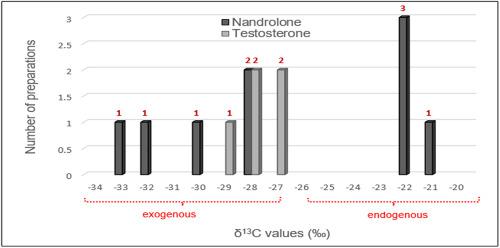当前位置:
X-MOL 学术
›
Drug Test. Anal.
›
论文详情
Our official English website, www.x-mol.net, welcomes your
feedback! (Note: you will need to create a separate account there.)
IRMS delta values (13C) of nandrolone and testosterone products available in the UK: Implications for anti‐doping
Drug Testing and Analysis ( IF 2.6 ) Pub Date : 2018-12-03 , DOI: 10.1002/dta.2530 Alan D. Brailsford 1 , Wan Noor Mahirah Majidin 1 , Nick Wojek 2 , David A. Cowan 1 , Christopher Walker 1
Drug Testing and Analysis ( IF 2.6 ) Pub Date : 2018-12-03 , DOI: 10.1002/dta.2530 Alan D. Brailsford 1 , Wan Noor Mahirah Majidin 1 , Nick Wojek 2 , David A. Cowan 1 , Christopher Walker 1
Affiliation

|
Anabolic androgenic steroids (AAS) are the most widely abused class of drugs by athletes and thus represent a significant problem to the anti‐doping community. Confirmation of a doping violation for AAS cannot always be based on their presence alone due to the endogenous production of some steroids. Both testosterone (and its metabolites) and the major diagnostic metabolite of nandrolone (19‐norandrosterone) are produced endogenously. Gas chromatography–combustion–isotope ratio mass spectrometry (GC–C–IRMS) is used in such cases to differentiate between the administration of a synthetic preparation and endogenous steroid production by measurement of their differing carbon isotope (13C/12C) ratio. The purpose of this study was to investigate the availability of steroid preparations in the UK with a 13C content analytically indistinguishable from that of endogenous steroids. Fourteen preparations containing nandrolone (n = 9) and testosterone (n = 5) were analyzed. The δ13C values were determined using GC–C–IRMS and the identity of the steroid preparations was confirmed using gas chromatography–mass spectrometry (GC–MS). Ten steroid preparations displayed δ13C values within the range expected for synthetic steroids (less than −27‰). However, four nandrolone preparations displayed δ13C values that overlap with the values considered to be endogenous in origin (range: −26 to −16‰). Misuse of these preparations could prevent the confirmation of nandrolone administration using GC–C–IRMS in anti‐doping cases.
中文翻译:

英国可提供的nandrolone和睾丸激素产品的IRMS delta值(13C):对反兴奋剂的影响
合成代谢雄激素类固醇(AAS)是运动员滥用最广泛的一类药物,因此对反兴奋剂社区构成了重大问题。由于某些类固醇是内源性产生的,因此不能总是仅基于它们的存在来确认是否违反了AAS。睾丸激素(及其代谢物)和nandrolone的主要诊断代谢物(19-去甲雄甾酮)都是内源性产生的。在这种情况下,使用气相色谱-燃烧-同位素比质谱(GC-C-IRMS)可以通过测量不同的碳同位素来区分合成制剂的施用和内源性类固醇的生产(13 C / 12C)比率。这项研究的目的是调查在英国,类固醇制剂的13 C含量与内源性类固醇的含量在分析上没有区别。分析了包含诺龙(n = 9)和睾丸激素(n = 5)的十四种制剂。的δ 13使用GC-C-IRMS测定C值和类固醇制剂的身份,使用气相色谱-质谱(GC-MS)确认。十类固醇制剂显示δ 13预期用于合成类固醇(小于-27‰)的范围内C值。然而,四种诺龙制剂显示δ 13C值与被认为是内源性的值重叠(范围:-26至-16‰)。滥用这些制剂可能会阻止在反兴奋剂病例中使用GC–C–IRMS确认诺龙的给药。
更新日期:2018-12-03
中文翻译:

英国可提供的nandrolone和睾丸激素产品的IRMS delta值(13C):对反兴奋剂的影响
合成代谢雄激素类固醇(AAS)是运动员滥用最广泛的一类药物,因此对反兴奋剂社区构成了重大问题。由于某些类固醇是内源性产生的,因此不能总是仅基于它们的存在来确认是否违反了AAS。睾丸激素(及其代谢物)和nandrolone的主要诊断代谢物(19-去甲雄甾酮)都是内源性产生的。在这种情况下,使用气相色谱-燃烧-同位素比质谱(GC-C-IRMS)可以通过测量不同的碳同位素来区分合成制剂的施用和内源性类固醇的生产(13 C / 12C)比率。这项研究的目的是调查在英国,类固醇制剂的13 C含量与内源性类固醇的含量在分析上没有区别。分析了包含诺龙(n = 9)和睾丸激素(n = 5)的十四种制剂。的δ 13使用GC-C-IRMS测定C值和类固醇制剂的身份,使用气相色谱-质谱(GC-MS)确认。十类固醇制剂显示δ 13预期用于合成类固醇(小于-27‰)的范围内C值。然而,四种诺龙制剂显示δ 13C值与被认为是内源性的值重叠(范围:-26至-16‰)。滥用这些制剂可能会阻止在反兴奋剂病例中使用GC–C–IRMS确认诺龙的给药。































 京公网安备 11010802027423号
京公网安备 11010802027423号